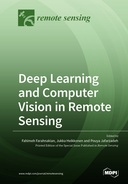Explore

Deep Learning and Computer Vision in Remote Sensing
0 Ungluers have
Faved this Work
Login to Fave
In the last few years, huge amounts of progress have been made regarding remote sensing in the field of computer vision. This success and progress is mostly due to the effectiveness of deep learning (DL) algorithms. In addition, the remote sensing community has shifted its attention to DL, and DL algorithms have been used to achieve significant success in many image analysis tasks. However, with regard to remote sensing, a number of challenges caused by difficulties in data acquisition and annotation have not been fully solved yet. This reprint is a collection of novel developments in the field of remote sensing using computer vision, deep learning, and artificial intelligence. The articles published involve fundamental theoretical analyses as well as those demonstrating their application to real-world problems.
This book is included in DOAB.
Why read this book? Have your say.
You must be logged in to comment.
Rights Information
Are you the author or publisher of this work? If so, you can claim it as yours by registering as an Unglue.it rights holder.Downloads
This work has been downloaded 76 times via unglue.it ebook links.
- 76 - pdf (CC BY) at Unglue.it.
Keywords
- 3D object detection
- 3D tracking
- aerial image generation
- anchor free
- Anchor Free Region Proposal Network
- angle-based detector
- angle-free framework
- ANN
- any angle object
- attention mechanism
- automatic classification
- band sensibility
- bidirectional domain adaptation
- binary code
- canopy height model
- cascade mask R-CNN
- commercial thinning
- contextual information
- contrastive learning
- convolution neural network
- convolutional neural network
- convolutional neural networks
- convolutional neural networks (CNNs)
- crater detection algorithm (CDA)
- cross entropy
- crossed spatial and spectral interactions
- data augmentation
- deep learning
- deep LK
- deep transfer learning
- deformable convolution
- dense connections
- digital surface model
- double-stream structure
- eccentricity-wise
- encoder–decoder network
- feature distillation
- Feedback
- forest fire
- GaN
- gated aggregation
- generative adversarial network
- generative adversarial networks
- generative adversarial networks (GANs)
- hashing algorithm
- high resolution image
- high-density laser scanning
- History of engineering & technology
- hyperspectral image classification
- image generation
- image matching
- image target detection
- image-to-image translation
- instance segmentation
- joint description
- keypoint-based detection
- Landsat-8
- logging trails
- Machine learning
- meteorological satellite images
- multilayer feature aggregation
- multiple scales
- multiview
- mutual guidance
- Neural Network
- object detection
- oriented bounding boxes
- oriented object detection
- Plastic
- point cloud
- point clouds
- polar representation
- R-FCN
- Remote sensing
- remote sensing disaster image
- remote sensing image
- remote sensing image retrieval
- remote sensing image scene classification (RSISC)
- remote sensing images
- remote sensing of small objects
- representative points
- residual block
- Risk mitigation
- rotated inscribed ellipse
- rotated object detection
- rotated region of interests (RRoIs)
- Sampling
- satellite and UAV image
- satellite image generation
- self-calibrated convolution
- self-constructing graph
- semantic segmentation
- Siamese network
- side-lobe suppression
- single-stage
- smoke segmentation
- Smoke-Unet
- spatial misalignment
- split attention mechanism
- state estimation
- structure map
- style vector
- super-resolution
- Swin transformer
- Technology, engineering, agriculture
- Technology: general issues
- Terahertz radar
- three-dimensional radar imaging
- transfer learning
- triplet ordinal relation preserving
- tropical cyclone detection
- u-net
- UAVs
- unsupervised domain adaptation
- variational autoencoder
- vehicle detection
Links
DOI: 10.3390/books978-3-0365-6369-5Editions

